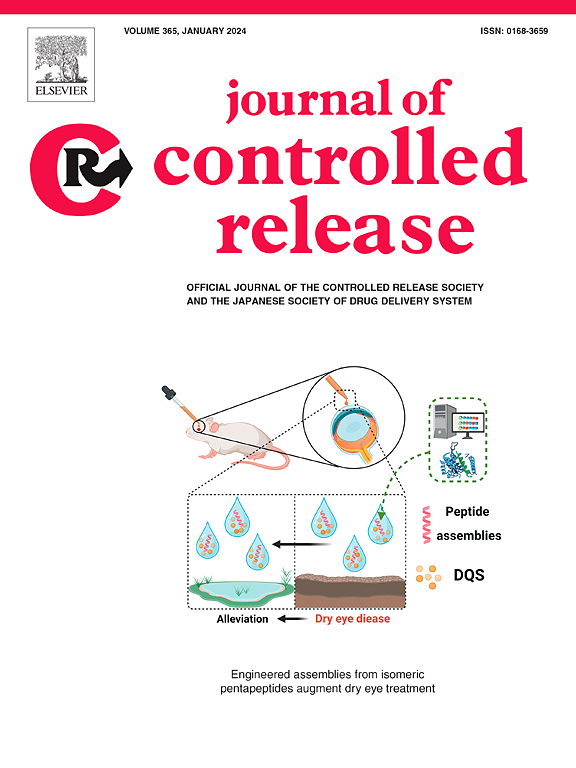人类Fc CH2结构域修饰胆囊炎胞吞途径以促进有效的口服治疗性蛋白递送
IF 10.5
1区 医学
Q1 CHEMISTRY, MULTIDISCIPLINARY
引用次数: 0
摘要
胆olix (Chx)外毒素的第一结构域可以利用与特定宿主细胞蛋白的相互作用,通过水泡状的顶端到底端(a → B)胞吞机制迅速穿过小肠上皮。这种无毒的Chx元素可以有效地运送共价附着的治疗蛋白货物,导致载体货物嵌合体沉积在固有层内,由于存在于细胞上的Chx受体,它被保留在固有层内。利用这一途径进行全身递送需要在上皮a转运后期与Chx分离 → B转运。在这里,我们使用furin蛋白酶特异性切割序列(FCS)基因结合蛋白质货物,人类生长激素(hGH),产生嵌合体,设计在肠上皮细胞基底区的furin+囊泡室中分离chx -货物嵌合体,以促进全身hGH的递送。我们的研究表明,在Chx载体的作用下,顶端furin+隔室的重新分布和增加,在这些隔室中,过早成熟的载体-货物分离事件将极大地限制使用这种FCS策略的全身hGH输送。大豆胰蛋白酶抑制剂的顶端应用阻断了Chx-FCS-hGH嵌合体的A → B转胞作用,可能是通过抑制与furin相关的RME相关的早期转运事件。我们现在表明,以位置特异性的方式将Chx载体与人类IgG1的Fc结构域CH2元件结合,提供了一种绕过根尖furin+囊泡室到达基底furin+囊泡室的机制,在那里FCS断裂允许高效的hGH释放到体循环中。RME后不久,肠细胞顶端区域的CH2-Chx载体与Fc受体样A蛋白的共定位表明,Chx偏离了通常由Chx进入的A → B胞食途径。使用一种优化的大鼠回肠递送溶液,我们观察到hGH到达体循环的量是使用CH2-Chx载体递送的材料的~4 %,表明治疗性蛋白质的口服递送可以通过靶向囊泡跨细胞途径实现。将霍乱弧菌外毒素蛋白cholix的结构域I与人IgG1 Fc结构域的CH2元件结合,导致该毒素元件使用的胞溶途径发生修饰,从而避免极化肠上皮细胞的顶端内体室,在那里furin样蛋白酶可以过早地分离基于cholix的嵌合体分子。本文章由计算机程序翻译,如有差异,请以英文原文为准。


Human Fc CH2 domain modifies cholix transcytosis pathway to facilitate efficient oral therapeutic protein delivery
The first domain of the cholix (Chx) exotoxin can rapidly cross small intestinal epithelium using a vesicular apical to basal (A → B) transcytosis mechanism that exploits interactions with specific host cell proteins. This non-toxic element of Chx can efficiently ferry a covalently attached therapeutic protein cargo that results in deposition of the carrier-cargo chimera within the lamina propria where it is retained due the presence of Chx receptors present on cells in this compartment. Systemic delivery of a cargo using this pathway requires separation from Chx at a late stage of epithelial A → B transcytosis. Here, we use a furin protease-specific cleavage sequence (FCS) to genetically conjoin a protein cargo, human growth hormone (hGH), to produce chimeras designed to separate a Chx-cargo chimera in a furin+ vesicular compartment in the basal region of intestinal epithelium cells to facilitate systemic hGH delivery. Our studies demonstrate that in response to the Chx carrier, there is a redistribution and augmentation of apical furin+ compartments where pre-mature carrier-cargo separation events would dramatically limit systemic hGH delivery using this FCS strategy. Apical application of soybean trypsin inhibitor blocked A → B transcytosis of the Chx-FCS-hGH chimera, likely by inhibiting early trafficking events associated with RME involving furin. We now show that combining the Chx carrier with the Fc domain CH2 element of human IgG1 in a position-specific manner provides a mechanism to bypass the apical furin+ vesicular compartment to reach the basal furin+ vesicular compartment where FCS scission allows for efficient hGH release into systemic circulation. Colocalization of the CH2-Chx carrier with the Fc receptor-like A protein in the apical region of enterocytes soon after RME demonstrates this deviation from the A → B transcytosis pathway normally accessed by Chx. Using a solution optimized for delivery to rat ileum we observed the amount of hGH reaching the systemic circulation to be ∼4 % of the material delivered using the CH2-Chx carrier, demonstrating that oral delivery of a therapeutic protein can be achieved using targeted vesicular transcellular routing.
One sentence summary
Combining domain I of the Vibrio cholerae exotoxin protein cholix with the CH2 element of the human IgG1 Fc domain results in a modification of the transcytosis pathway used by this toxin element that avoids the apical endosomal compartment of polarized intestinal epithelial cell where furin-like proteases can prematurely separate cholix-based chimera molecules.
求助全文
通过发布文献求助,成功后即可免费获取论文全文。
去求助
来源期刊

Journal of Controlled Release
医学-化学综合
CiteScore
18.50
自引率
5.60%
发文量
700
审稿时长
39 days
期刊介绍:
The Journal of Controlled Release (JCR) proudly serves as the Official Journal of the Controlled Release Society and the Japan Society of Drug Delivery System.
Dedicated to the broad field of delivery science and technology, JCR publishes high-quality research articles covering drug delivery systems and all facets of formulations. This includes the physicochemical and biological properties of drugs, design and characterization of dosage forms, release mechanisms, in vivo testing, and formulation research and development across pharmaceutical, diagnostic, agricultural, environmental, cosmetic, and food industries.
Priority is given to manuscripts that contribute to the fundamental understanding of principles or demonstrate the advantages of novel technologies in terms of safety and efficacy over current clinical standards. JCR strives to be a leading platform for advancements in delivery science and technology.
 求助内容:
求助内容: 应助结果提醒方式:
应助结果提醒方式:


